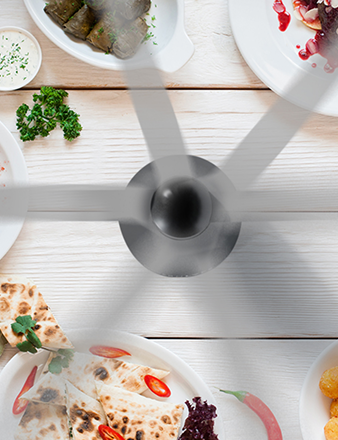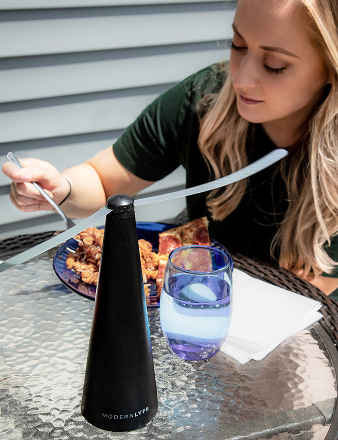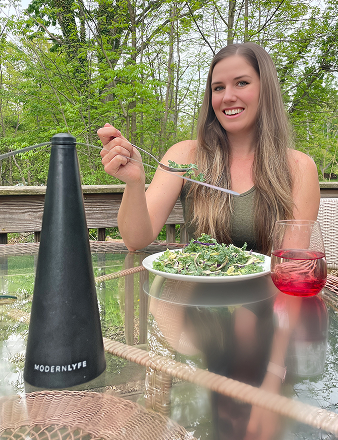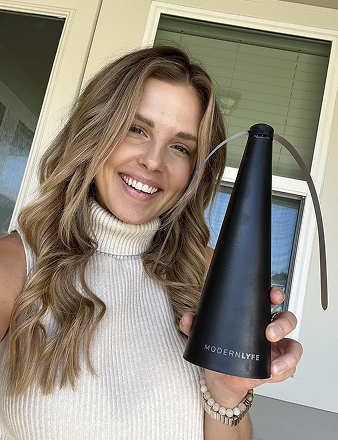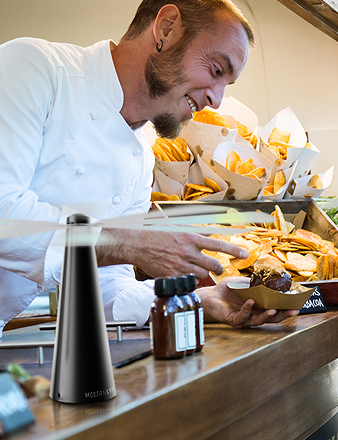One day your kitchen is spotless; the next, a cloud of tiny flies has taken over your fruit bowl. Where did they come from?
They hitched a ride. Fruit flies are experts at sneaking into your home on produce. They’re drawn to the scent of fermentation, and a single female can lay up to 500 eggs on ripening fruit or in a damp drain. To get rid of them, you have to cut them off at the source.
Where Fruit Flies Actually Come From
That swarm of tiny insects isn't a mystery—it's biology. These pests, Drosophila melanogaster, have an incredible sense of smell for anything fermenting, which tells them it's the perfect spot to lay eggs.
Even a piece of fruit with a tiny bruise can carry their eggs. Once that produce is in your warm home, their life cycle speeds up, and a few flies can become an infestation in days.
The Rapid Lifecycle Explained
Fruit flies multiply shockingly fast. It’s why a small problem escalates so quickly. In ideal conditions, they go from egg to adult in just 8 to 10 days. This breakneck pace means a few unnoticed flies can explode into a swarm before you even realize what’s happening.
Don't just swat the adult flies you see. The real fight is against the hidden eggs and larvae. If you don't eliminate their breeding grounds, a new generation will just hatch and take their place.
You have to be strategic. Getting rid of adult flies won't solve the problem. You have to break the cycle at its source.
Find Their Hidden Breeding Grounds
Your fruit bowl is the obvious suspect, but fruit flies are resourceful. They will make a home anywhere there’s moisture and decaying organic matter. Finding these hidden nurseries is your first and most important mission.
Here are the most common hotspots:
- Sink Drains & Garbage Disposals: Tiny food particles create a slimy film inside your pipes—a perfect breeding ground.
- Damp Sponges & Mops: That sour-smelling sponge by the sink could be ground zero.
- Recycling Bins: A little leftover soda, beer, or wine in the bottom of a can is more than enough for them.
- Garbage Cans: Sticky spills and leaks inside the bin create a protected breeding environment.
Don't stop in the kitchen. They're also known to breed in the damp soil of overwatered houseplants. A thorough search of these areas is the only way to get rid of fruit flies for good.
This isn't just a home annoyance; it's a massive agricultural problem. Fruit flies cause billions in crop damage worldwide. A recent outbreak was called the worst fruit fly outbreak in 70 years, which shows just how serious these pests are.
Pinpointing the source of your fruit fly problem is detective work. This table helps you narrow down the suspects and act fast.
Common Fruit Fly Sources and Quick Fixes
| Hotspot | Why They Gather Here | Your First Action |
|---|---|---|
| Fruit Bowl | Overripe or bruised produce is their primary target for food and eggs. | Immediately toss any spoiled fruit and store the rest in the fridge. |
| Sink Drains | Food sludge builds up, creating a constant source of moisture and decay. | Pour boiling water down the drain, followed by a vinegar and baking soda solution. |
| Garbage Cans | Spills, leaks, and forgotten food scraps create a welcoming environment. | Empty the trash, then scrub the inside of the can with hot, soapy water. |
| Recycling Bins | Sugary residue in unrinsed cans and bottles is a powerful magnet. | Thoroughly rinse all cans and bottles before tossing them in the bin. |
| Wet Sponges/Mops | These items trap moisture and food particles, becoming surprise breeding grounds. | Wring out sponges completely, store them dry, and wash mop heads regularly. |
Check these areas first. You can often find and eliminate the root of the infestation in minutes.
Proven Methods to Eliminate Fruit Flies Now
Once you've found the source, it's time to go on the offensive. The adult flies are your immediate target. Getting rid of them is key to breaking the breeding cycle and taking back your space.
This isn't about swatting them one by one. You need a strategy that works 24/7 to trap and eliminate the current population before they can lay hundreds more eggs.
The DIY Fruit Fly Trap That Actually Works
You don't need special gear to make a dent in a fruit fly population. One of the most effective weapons is a simple trap made from household items. The apple cider vinegar trap is a classic for one reason: it works. It mimics the smell of fermenting fruit, which they can't resist.
Here's how to make one:
- Get a small jar or bowl and pour in an inch of apple cider vinegar.
- Add 2-3 drops of dish soap. This is essential. The soap breaks the vinegar's surface tension, so flies can't land for a drink. They sink and drown.
- Gently swirl it and set it in the hot zone—next to the fruit bowl, by the sink, or near the trash can.
To make it even more effective, drop a small piece of overripe banana into the vinegar. That super-sweet, fermented scent acts like a homing beacon. For more tips, check out our guide on how to make a food fly trap.
This infographic is a great visual reminder of where these pests hang out.
As you can see, overripe bananas, damp sponges, and grimy drains are the top culprits. No surprise there.
Commercial and Store-Bought Solutions
Sometimes, a DIY trap isn't enough, especially for a serious infestation or in a commercial space like a bar. In those cases, it's time for professional-grade products.
Store-bought solutions are designed for maximum impact and are often more discreet.
- Adhesive Traps: These are non-toxic sticky traps, often shaped like windows or leaves, that you place near hotspots. A food-based lure draws the flies in.
- Plug-in Light Traps: These devices use a gentle UV light and warmth to attract flying pests. Once inside, they get stuck on a hidden adhesive pad.
- Liquid Bait Traps: These are pre-packaged, supercharged versions of the DIY vinegar trap. They come in sealed, disposable containers with powerful bait formulas.
Comparing DIY and Commercial Fruit Fly Traps
Deciding between a homemade solution and a store-bought one can be tricky. This table breaks down the differences to help you choose the best trap for your situation.
| Trap Type | How It Works | Pros | Cons | Best Use Case |
|---|---|---|---|---|
| DIY Vinegar Trap | Uses apple cider vinegar and dish soap to attract and drown flies. | Extremely cheap; uses common kitchen ingredients; non-toxic. | Can be unsightly; needs to be refreshed every few days; may not be enough for large infestations. | Minor infestations in a home kitchen or for quick, immediate action. |
| Adhesive Trap | A sticky surface, often with a lure, physically traps flies. | Non-toxic; discreet designs available; works silently. | Can look gross once full; loses stickiness over time; less effective in dusty areas. | Near windows, fruit bowls, or house plants where flies tend to gather. |
| Liquid Bait Trap | Pre-filled containers use a liquid bait to lure and trap flies. | Highly effective formulas; discreet and disposable; no-mess setup. | Ongoing cost; single-use plastic; bait can have a chemical smell. | Persistent problems in homes or small businesses needing a reliable solution. |
| Plug-in Light Trap | UV light attracts flies to a hidden sticky board. | Catches a variety of flying insects; works 24/7; very discreet. | Requires an electrical outlet; higher initial cost; needs replacement cartridges. | Restaurants, bars, and homes that want a continuous, hands-off solution. |
The best choice depends on the scale of your problem. For a minor issue, a DIY trap is a great first step. For a business or a stubborn infestation, a commercial product is a smart investment.
For anyone in the food service industry, commercial-grade traps are non-negotiable. They're built to handle a higher volume of pests discreetly, keeping your establishment clean and professional.
Remember, trapping is just one piece of the puzzle. It works best when combined with other pest management strategies. If you have houseplants, exploring natural pest control methods for plants can help. The key to long-term success is pairing effective trapping with relentless source elimination.
Long-Term Prevention: How to Keep Fruit Flies Away

Trapping the fruit flies you see is a quick win, but it's just the first step. If you don't fix the reason they showed up, you’re just waiting for the next swarm. The real secret to keeping fruit flies away for good is making your space an environment where they can't survive.
It's about shifting from a reactive mindset—"Ugh, flies again!"—to a proactive one. A solid prevention plan is built on consistent sanitation habits that cut off their food and breeding grounds. Make these practices second nature, and you'll make your home permanently inhospitable to these pests.
Your Deep-Cleaning Checklist
Fruit flies are masters at finding grime in places you rarely look. To shut them down, you have to target those hidden spots where moisture and organic gunk build up. Adding these tasks to your regular cleaning schedule is a game-changer.
Here's your go-to checklist for those forgotten problem areas:
- Drains and Garbage Disposals: Pour boiling water down your drains weekly to dissolve sludge. For a deeper clean, use a stiff brush to scrub the inside of the garbage disposal's rubber flange—it’s a notorious hiding spot for gunk.
- Underneath Appliances: Sticky residue and crumbs hide under microwaves, coffee makers, and toasters. Once a week, lift these small appliances and wipe the counter underneath.
- Trash Can Maintenance: Don't just take out the trash. Clean the can itself at least monthly. Scrub the inside with hot, soapy water to remove any spilled residue that attracts flies.
Vigilance is key. A forgotten spill or a leaky trash bag is all it takes for fruit flies to move in. Making these deep-cleaning tasks a non-negotiable part of your routine is the most effective way to keep them from coming back.
Smart Produce Storage
How you store produce can either be an open invitation for an infestation or your first line of defense. Ripe, fermenting produce is their number one target, so managing it properly is non-negotiable. Don't let your counter become their buffet.
Adopt these storage habits to cut off their food supply:
- Refrigerate Ripe Fruit: As soon as bananas get spotty or peaches get fragrant, put them in the fridge. The cold slows down ripening and keeps them safe from flies.
- Isolate Onions and Potatoes: Root vegetables like potatoes and onions need a cool, dark, dry spot—not the refrigerator. Check them regularly and toss any that show signs of rot.
- Cover Everything: Use a simple food cover to shield anything left on the counter, from meal prep ingredients to cooling baked goods. This barrier is an incredibly effective layer of protection.
Protocols for Hospitality Settings
For restaurants, bars, and cafes, the stakes are much higher. A fruit fly problem can damage your reputation and lead to health code violations. A commercial kitchen needs a more rigorous prevention plan.
- Bar Mat and Drain Cleaning: Floor mats and drains under beer taps and soda stations are hotspots. They must be cleaned and sanitized daily to eliminate sugary spills.
- Tap and Line Maintenance: Beer taps, soda guns, and their lines have to be flushed and cleaned on a strict schedule to prevent the yeast and sugar buildup that fruit flies love.
- Empty Bottle Management: Ensure all empty wine, beer, and liquor bottles are rinsed out before recycling. The sugary residue at the bottom is all it takes to attract a swarm.
This multi-pronged approach mirrors strategies used in large-scale agriculture. The industry has cut fruit fly infestations by over 10-20% in heavily affected regions using a combination of monitoring, trapping, and sanitation. You can learn more in this detailed research review. The lesson is clear: a comprehensive plan that attacks the problem from all angles is the only way to win.
Modern Tech to Keep Flies Away

You’ve deep-cleaned your space and set traps to catch any stragglers. That’s a great start, but those are reactive measures. It's time to get proactive and add a modern layer of defense that stops them before they even land.
The goal is to create an environment where fruit flies physically can't land on your food. Forget chemical sprays or smelly traps. This approach uses simple physics to create an invisible barrier around your food and drinks. It’s a clean, quiet, and effective way to get rid of fruit flies without the usual hassle.
The Science of Air Disruption
Here's something you might not know: fruit flies are terrible fliers. They’re tiny and weigh almost nothing, so even a gentle breeze sends them tumbling. This is the simple principle behind tools like Modern Lyfe’s fly fans.
These fans don't zap, spray, or capture anything. They create a subtle, continuous air current that fruit flies find impossible to navigate. When a fly tries to land on your fruit bowl, the gentle wind from the fan blades disorients it and pushes it away. You've essentially created a "no-fly zone."
It’s a simple concept that turns the flies' own weakness against them. No chemicals, no odors, and no dead bugs to clean up—just a constant, silent defense that keeps your space hygienic.
What makes this method so powerful is that it's preemptive. You’re not waiting for flies to land; you're stopping them mid-air.
Practical Uses for Fly Fans
One of the best things about a portable, battery-operated fly fan is its versatility. You can place it exactly where you need it, making it perfect for both everyday situations and special events.
Consider these common scenarios:
- Meal Prep: Place a fan on your kitchen counter while you’re chopping vegetables or arranging a fruit platter to keep ingredients protected.
- Outdoor Dining: Nothing ruins a barbecue faster than swatting at flies. A fan on the patio table lets your guests enjoy their food in peace.
- Buffets and Events: For caterers or event planners, placing a few fans along a buffet line protects the food and keeps the entire setup looking professional.
This kind of proactive defense is a smart move for anyone serious about hygiene. Learn more about how a fly fan works in our detailed guide. It's an elegant solution that complements your cleaning efforts with 24/7 protection.
Troubleshooting a Stubborn Fruit Fly Problem
https://www.youtube.com/embed/V-w4GmHLUTo
You’ve set the traps and scrubbed every surface, but you're still seeing those tiny pests buzzing around. It's frustrating. When the usual tricks don't work, it's a sure sign the fruit flies have found a hidden breeding ground.
This is where you need to become a detective. A persistent infestation isn't about being dirty; it's almost always tied to an overlooked source of moisture and organic material. It's time to think beyond the obvious.
Uncovering Overlooked Breeding Grounds
When a problem won't quit, think like a fly. Where is it damp, dark, and full of gunk? Often, the answer is in a spot that's not on your daily cleaning list.
Here are the most common secret hideouts:
- Refrigerator Drip Pan: Tucked at the bottom of most refrigerators is a shallow pan that catches condensation. It’s dark, moist, and dusty—a five-star hotel for fruit flies.
- Houseplant Soil: Overwatered houseplants with consistently damp soil, especially with a few fallen leaves, create an ideal nursery.
- Damp Mops or Rags: That sour mop in the utility closet or the wet rag balled up under the sink can stay damp for days, giving flies the perfect place to lay eggs.
- Floor Drains: A big one, especially in basements, laundry rooms, or commercial kitchens. The biofilm and grime inside these drains are a breeding paradise.
A Deeper Investigation
Finding the source is about being methodical, not lucky. Start by emptying every trash can in the house and deep-cleaning the inside of each bin.
Next, pull your refrigerator out from the wall. Inspect and scrub the drip pan until it's spotless. Then, move on to your plants. Carefully check the soil of every houseplant for signs of tiny flies or larvae.
When standard fixes fail, the source is unconventional. I once traced a restaurant infestation to a single rotting potato that had rolled into a dark corner of the pantry. Challenge your assumptions about where flies can breed.
Sometimes, a severe infestation requires a different mindset. Scientists handle this on a massive scale with the Sterile Insect Technique (SIT), where they release sterilized male flies that mate with wild females. Since the eggs aren't viable, the population crashes. This method was used to wipe out a major outbreak in record time. Read more about this powerful eradication technique and its success.
You won't be releasing sterile flies in your kitchen, but the principle is the same: even the most overwhelming problems can be solved if you find and eliminate the source.
Your Top Fruit Fly Questions, Answered
Even the best plan can leave you with questions. Let's tackle the most common ones so you can get a fly-free space for good.
How Long Does It Really Take to Get Rid of Fruit Flies?
It all depends on how aggressively you eliminate their breeding cycle. If you go all-in—removing all food sources and setting traps—you'll see a huge drop in adult flies in just 2-3 days.
But don't stop there. A fruit fly goes from egg to adult in a startlingly short 8 to 10 days. You must stay vigilant with cleaning and trapping for at least two weeks. This ensures you catch any new generations before they have a chance to lay more eggs.
Can Fruit Flies Actually Live in My Sink Drain?
Yes. Your sink drain is prime real estate for fruit flies and their relatives, drain flies. It's a dark, moist hideout where gunk—food bits, soap scum, and grime—builds into a slimy film. It's the perfect nursery for their eggs.
Here’s a simple way to clean them out:
- Pour a kettle of boiling water down the drain to loosen greasy buildup.
- Follow it with a mix of baking soda and white vinegar. The fizzing action helps scrub the inside of your pipes.
- Let it sit for 10-15 minutes, then flush it all out with more hot water.
Make this a regular part of your cleaning routine to keep them from coming back.
It's easy to dismiss fruit flies as just annoying, but they pose a real health risk. They travel from a dirty garbage can or a slimy drain directly to your food, potentially transferring bacteria along the way.
Are Fruit Flies Harmful?
While a few fruit flies are unlikely to make you sick, their presence is a food safety red flag you can't ignore. They are a direct link between unsanitary surfaces and your plate.
This is especially critical in restaurants, cafes, or homes where someone has a compromised immune system. Getting rid of them isn't just about appearances; it’s a crucial step in maintaining a clean and healthy environment.
Do Fly Fans Like the Modern Lyfe Fan Work Outdoors?
Absolutely. This is where fly fans really shine. When you're trying to enjoy a meal on the patio or at a barbecue, a fly fan is a game-changer.
The fan's blades create a gentle but effective air current that disrupts a fly's path. This invisible barrier makes it nearly impossible for fruit flies, house flies, and other pests to land on your food. Because they're portable and battery-powered, they are the ideal chemical-free way to enjoy the outdoors without uninvited guests.
Ready to create a permanent no-fly zone in your home or business? The MODERN LYFE fly fan offers a silent, effective, and elegant solution to keep your food protected and your space hygienic. Discover the difference and shop our collection today at modernlyfe.com.

